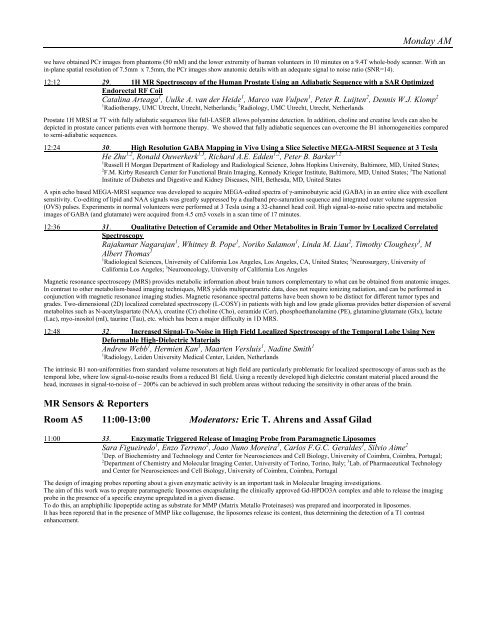OPENING SESSION - ismrm
OPENING SESSION - ismrm
OPENING SESSION - ismrm
You also want an ePaper? Increase the reach of your titles
YUMPU automatically turns print PDFs into web optimized ePapers that Google loves.
Monday AM<br />
we have obtained PCr images from phantoms (50 mM) and the lower extremity of human volunteers in 10 minutes on a 9.4T whole-body scanner. With an<br />
in-plane spatial resolution of 7.5mm x 7.5mm, the PCr images show anatomic details with an adequate signal to noise ratio (SNR=14).<br />
12:12 29. 1H MR Spectroscopy of the Human Prostate Using an Adiabatic Sequence with a SAR Optimized<br />
Endorectal RF Coil<br />
Catalina Arteaga 1 , Uulke A. van der Heide 1 , Marco van Vulpen 1 , Peter R. Luijten 2 , Dennis W.J. Klomp 2<br />
1 Radiotherapy, UMC Utrecht, Utrecht, Netherlands; 2 Radiology, UMC Utrecht, Utrecht, Netherlands<br />
Prostate 1H MRSI at 7T with fully adiabatic sequences like full-LASER allows polyamine detection. In addition, choline and creatine levels can also be<br />
depicted in prostate cancer patients even with hormone therapy. We showed that fully adiabatic sequences can overcome the B1 inhomogeneities compared<br />
to semi-adiabatic sequences.<br />
12:24 30. High Resolution GABA Mapping in Vivo Using a Slice Selective MEGA-MRSI Sequence at 3 Tesla<br />
He Zhu 1,2 , Ronald Ouwerkerk 1,3 , Richard A.E. Edden 1,2 , Peter B. Barker 1,2<br />
1 Russell H Morgan Department of Radiology and Radiological Science, Johns Hopkins University, Baltimore, MD, United States;<br />
2 F.M. Kirby Research Center for Functional Brain Imaging, Kennedy Krieger Institute, Baltimore, MD, United States; 3 The National<br />
Institute of Diabetes and Digestive and Kidney Diseases, NIH, Bethesda, MD, United States<br />
A spin echo based MEGA-MRSI sequence was developed to acquire MEGA-edited spectra of γ-aminobutyric acid (GABA) in an entire slice with excellent<br />
sensitivity. Co-editing of lipid and NAA signals was greatly suppressed by a dualband pre-saturation sequence and integrated outer volume suppression<br />
(OVS) pulses. Experiments in normal volunteers were performed at 3 Tesla using a 32-channel head coil. High signal-to-noise ratio spectra and metabolic<br />
images of GABA (and glutamate) were acquired from 4.5 cm3 voxels in a scan time of 17 minutes.<br />
12:36 31. Qualitative Detection of Ceramide and Other Metabolites in Brain Tumor by Localized Correlated<br />
Spectroscopy<br />
Rajakumar Nagarajan 1 , Whitney B. Pope 1 , Noriko Salamon 1 , Linda M. Liau 2 , Timothy Cloughesy 3 , M<br />
Albert Thomas 1<br />
1 Radiological Sciences, University of California Los Angeles, Los Angeles, CA, United States; 2 Neurosurgery, University of<br />
California Los Angeles; 3 Neurooncology, University of California Los Angeles<br />
Magnetic resonance spectroscopy (MRS) provides metabolic information about brain tumors complementary to what can be obtained from anatomic images.<br />
In contrast to other metabolism-based imaging techniques, MRS yields multiparametric data, does not require ionizing radiation, and can be performed in<br />
conjunction with magnetic resonance imaging studies. Magnetic resonance spectral patterns have been shown to be distinct for different tumor types and<br />
grades. Two-dimensional (2D) localized correlated spectroscopy (L-COSY) in patients with high and low grade gliomas provides better dispersion of several<br />
metabolites such as N-acetylaspartate (NAA), creatine (Cr) choline (Cho), ceramide (Cer), phosphoethanolamine (PE), glutamine/glutamate (Glx), lactate<br />
(Lac), myo-inositol (mI), taurine (Tau), etc. which has been a major difficulty in 1D MRS.<br />
12:48 32. Increased Signal-To-Noise in High Field Localized Spectroscopy of the Temporal Lobe Using New<br />
Deformable High-Dielectric Materials<br />
Andrew Webb 1 , Hermien Kan 1 , Maarten Versluis 1 , Nadine Smith 1<br />
1 Radiology, Leiden University Medical Center, Leiden, Netherlands<br />
The intrinsic B1 non-uniformities from standard volume resonators at high field are particularly problematic for localized spectroscopy of areas such as the<br />
temporal lobe, where low signal-to-noise results from a reduced B1 field. Using a recently developed high dielectric constant material placed around the<br />
head, increases in signal-to-noise of ~ 200% can be achieved in such problem areas without reducing the sensitivity in other areas of the brain.<br />
MR Sensors & Reporters<br />
Room A5 11:00-13:00 Moderators: Eric T. Ahrens and Assaf Gilad<br />
11:00 33. Enzymatic Triggered Release of Imaging Probe from Paramagnetic Liposomes<br />
Sara Figueiredo 1 , Enzo Terreno 2 , Joao Nuno Moreira 3 , Carlos F.G.C. Geraldes 1 , Silvio Aime 2<br />
1 Dep. of Biochemistry and Technology and Center for Neurosciences and Cell Biology, University of Coimbra, Coimbra, Portugal;<br />
2 Department of Chemistry and Molecular Imaging Center, University of Torino, Torino, Italy; 3 Lab. of Pharmaceutical Technology<br />
and Center for Neurosciences and Cell Biology, University of Coimbra, Coimbra, Portugal<br />
The design of imaging probes reporting about a given enzymatic activity is an important task in Molecular Imaging investigations.<br />
The aim of this work was to prepare paramagnetic liposomes encapsulating the clinically approved Gd-HPDO3A complex and able to release the imaging<br />
probe in the presence of a specific enzyme upregulated in a given disease.<br />
To do this, an amphiphilic lipopeptide acting as substrate for MMP (Matrix Metallo Proteinases) was prepared and incorporated in liposomes.<br />
It has been reporetd that in the presence of MMP like collagenase, the liposomes release its content, thus determining the detection of a T1 contrast<br />
enhancement.















